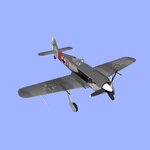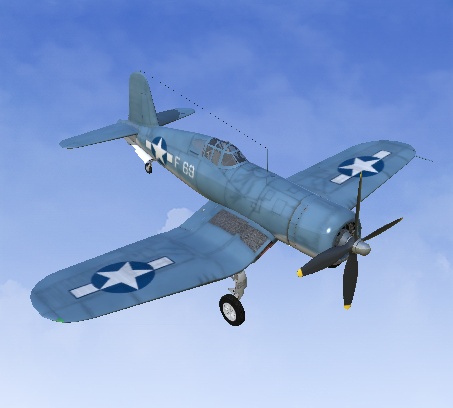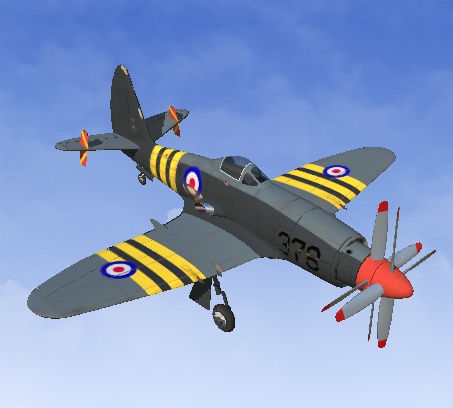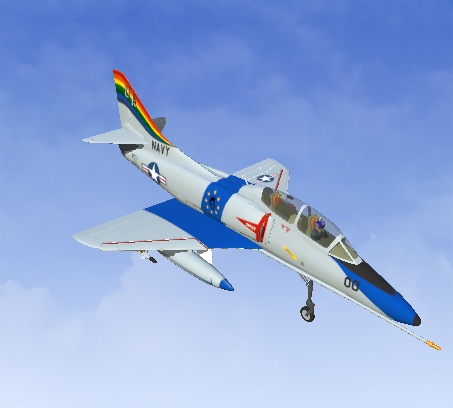Edit of my Fw-190 variant. A few pounds heavier and a bit faster( about 200mph). Have Fun!
FW-190 Facts:
The Focke-Wulf Fw 190 Würger ("shrike"), also called Butcher-bird, was a single-seat, single-engine fighter aircraft of Germany's Luftwaffe. Used extensively during the Second World War, over 20,000 were manufactured, including around 6,000 fighter-bomber models. Production ran from 1941 to the end of hostilities, during which time the aircraft was continually updated. Its later versions retained qualitative parity with Allied fighter planes, but Germany was not able to produce the aircraft in enough numbers to affect the outcome of the war.
The Fw 190 was well liked by its pilots, and was quickly proven to be superior to the RAF's main front line fighter, the Spitfire Mk. V, on its combat debut in 1941.[1][2] Compared to the Bf 109, the Fw 190 was a "workhorse", employed in and proved suitable for a wide variety of roles, including ground attack, night fighter-bomber, long-range bomber escort, and night-fighter.
Early development
Fw 190 A
Fw 190 A
In autumn 1937, the Reichsluftfahrtministerium (RLM) or Reich Air Ministry asked various designers for a new fighter to fight alongside the Messerschmitt Bf 109, Germany's front line fighter. Although the Bf 109 was at that point an extremely competitive fighter, the RLM was worried that future foreign designs might outclass it and wanted to have new aircraft under development to meet these possible challenges.[3]
Kurt Tank responded with a number of designs, most incorporating liquid-cooled inline engines. However, it was not until a design was presented using the air-cooled, 14-cylinder BMW 139 radial engine that the RLM's interest was aroused. At the time, the use of radial engines was unusual in Europe because of their large frontal area and the belief that they caused too much drag to allow for a competitive design. Tank was not convinced of this, having witnessed the success of radial engines as used by the US Navy, and designed a highly streamlined mounting for the engine.[4] Instead of leaving the front of the engine "open" to allow cooling air to flow over the cylinders, Tank used a very small opening between the engine cowling and an oversized propeller spinner to admit air. In theory, the use of the tight-fitting cowling also provided some thrust due to the compression of air at speed through the cowling.[5] It was also believed that because the Fw 190 used a radial engine it would not affect production of the Bf 109, furthering the RLM's interest in the Fw 190.[4]
Another revolutionary aspect of the new design was the extensive use of electrically powered equipment replacing the hydraulic systems used by most aircraft manufacturers of the time. On the first two prototypes (described below) the main undercarriage was hydraulic. Starting with the third prototype the undercarriage was operated by push-buttons in the cockpit controlling electric motors in the wings, and was kept in position by electric up- and down-locks.[6]. Similarly the electrically operated landing flaps were controlled by buttons in the cockpit as was the variable incidence tailplane, which could be used to flight-trim the aircraft. The fixed armament was also charged and fired electrically. Kurt Tank believed that service use would prove the electrically powered systems would be more reliable and more rugged than hydraulics, as well as being much easier to service when needed and the absence of flammable hydraulic fluids and vulnerable piping, which was usually prone to leakage, would reduce the fire-risk.
Tank also designed an extremely clean cockpit layout, aided by the use of the electrical equipment. The cockpit had most of the main controls laid out in a logical pattern and incorporated into consoles on either side of the pilot, rather than being placed on the fuselage skinning.
Modern Fw 190
Starting in 1997, a small German company, Flug Werk GmbH,[56] began work on a new Fw 190 A-8. These Fw 190 A-8s are new builds from the ground up, using many original dies, plans and other information from the war. Werk numbers continued from where the German war machine left off with the new Fw 190 A-8 labeled FW 190 A-8/N (N for Nachbau (English: "reproduction, replica or clone"). Some of these new Fw 190s are known to be fitted with the original tail wheel units from the Second World War; a small cache of tail gear having been discovered. In November 2005, the first flights were completed. Ironically, since the BMW 801 engines are no longer available, a Chinese licenced Russian engine, the ASh-82FN 14-cylinder twin-row radial engine, which powered some of the Fw 190's opposition: the La-5 and La-7, powers the new FW 190 A-8/N. Flugwerk was also instrumental in the restoration of perhaps the only Fw 190 A-9 in existence. The aircraft is currently being restored in Duxford, England for a US owner.
Work has also been recently started on a Fw 190 D-9, and, again in a bit of irony, will be powered by a modified Allison V-1710 V-12, the powerplant of the P-39 Airacobra, another foe of the Fw 190 often flown by Russian forces in the Second World War. Recently this aircraft, known as Black 12, arrived in Kissimmee, FL, and on 12 December 2007, had its first engine run.[57]
The FW 190 A-8/N participated in the Finnish war movie Tali-Ihantala 1944, painted in the same markings as Oberst Erich Rudorffer's aircraft in 1944.[58] The movie was released in December 2007.[59]
The White 1 Foundation, primarily involved in the restoration to airworthiness of an original Fw 190 F (the White 1, last flown by Unteroffizier Heinz Orlowski in World War II) that served with the "Arctic Ocean Fighter Wing" of the Luftwaffe, JG 5 "Eismeer", also has a pair of vintage Junkers Jumo 213 engines in its collection, complete with original annular radiators, possibly as vintage Kraftei power-egg unitized engine installations, and apparently plans an Fw 190 D-9 reproduction aircraft project of its own based on one of the engines.
Specifications (Fw 190 A-8)
Data from Fw 190 A8
General characteristics
* Crew: One
* Length: 9.00 m (29 ft 0 in)
* Wingspan: 10.51 m (34 ft 5 in)
* Height: 3.95 m (12 ft 12 in)
* Wing area: 18,30 m² (196.99 ft²)
* Empty weight: 3,200 kg (7,060 lb)
* Loaded weight: 4,417 kg (9,735 lb)
* Max takeoff weight: 4,900 kg (10,800 lb)
* Powerplant: 1× BMW 801 D-2 radial engine, 1,272 kW (1,730 hp); 1,471 kW (2,000 hp) with boost
Performance
* Maximum speed: 656 km/h at 4,800 m, 685 km/h with boost (383 mph at 19,420 ft, 408 mph with boost)
* Range: 800 km (500 miles)
* Service ceiling 11,410 m (37,430 ft)
* Rate of climb: 13 m/s (2560 feet/min)
* Wing loading: 241 kg/m² (49.4 lb/ft²)
* Power/mass: 0.29 - 0.33 kW/kg (0.18 - 0.21 hp/lb)
Armament
* 2× 13 mm MG 131 machine guns with 475 rounds/gun
* 4× 20 mm MG 151/20 E cannons with 250 rounds/gun in the wing root and 140 rounds/gun outboard.
[edit] Specifications (Fw 190 D-9)
General characteristics
* Crew: 1
* Length: 10.20 m (33 ft 5 1/2 in)
* Wingspan: 10.50 m (34 ft 5 in)
* Height: 3.35 m (11 ft 0 in)
* Wing area: 18.30 m² (196.99 ft²)
* Empty weight: 3,490 kg (7,694 lb)
* Loaded weight: 4,350 kg (9,590 lb)
* Max takeoff weight: 4,840 kg (10,670 lb)
* Powerplant: 1× Junkers Jumo 213 A-1 12-cylinder inverted-Vee piston engine, 1,287 kW, 1,544 kW with boost (1,750 PS / 2,100 PS)
Performance
* Maximum speed: 685 km/h at 6,600 m, 710 km/h at 11,300 m (426 mph at 21,655 ft / 440 mph at 37,000 ft)
* Range: 835 km (519 mi)
* Service ceiling 12,000 m (39,370 ft)
* Rate of climb: 17 m/s (3,300 feet/min)
* Wing loading: 238 kg/m² (48.7 lb/ft²)
* Power/mass: 0.30 - 0.35 kw/kg (0.18 - 0.21 hp/lb)
Armament
* 2× 13 mm MG 131 machine guns
* 2× 20 mm MG 151 cannons
* 1× 500 kg (1,102 lb) SC 500 bomb (optional)
Wikipedia
FW-190 Facts:
The Focke-Wulf Fw 190 Würger ("shrike"), also called Butcher-bird, was a single-seat, single-engine fighter aircraft of Germany's Luftwaffe. Used extensively during the Second World War, over 20,000 were manufactured, including around 6,000 fighter-bomber models. Production ran from 1941 to the end of hostilities, during which time the aircraft was continually updated. Its later versions retained qualitative parity with Allied fighter planes, but Germany was not able to produce the aircraft in enough numbers to affect the outcome of the war.
The Fw 190 was well liked by its pilots, and was quickly proven to be superior to the RAF's main front line fighter, the Spitfire Mk. V, on its combat debut in 1941.[1][2] Compared to the Bf 109, the Fw 190 was a "workhorse", employed in and proved suitable for a wide variety of roles, including ground attack, night fighter-bomber, long-range bomber escort, and night-fighter.
Early development
Fw 190 A
Fw 190 A
In autumn 1937, the Reichsluftfahrtministerium (RLM) or Reich Air Ministry asked various designers for a new fighter to fight alongside the Messerschmitt Bf 109, Germany's front line fighter. Although the Bf 109 was at that point an extremely competitive fighter, the RLM was worried that future foreign designs might outclass it and wanted to have new aircraft under development to meet these possible challenges.[3]
Kurt Tank responded with a number of designs, most incorporating liquid-cooled inline engines. However, it was not until a design was presented using the air-cooled, 14-cylinder BMW 139 radial engine that the RLM's interest was aroused. At the time, the use of radial engines was unusual in Europe because of their large frontal area and the belief that they caused too much drag to allow for a competitive design. Tank was not convinced of this, having witnessed the success of radial engines as used by the US Navy, and designed a highly streamlined mounting for the engine.[4] Instead of leaving the front of the engine "open" to allow cooling air to flow over the cylinders, Tank used a very small opening between the engine cowling and an oversized propeller spinner to admit air. In theory, the use of the tight-fitting cowling also provided some thrust due to the compression of air at speed through the cowling.[5] It was also believed that because the Fw 190 used a radial engine it would not affect production of the Bf 109, furthering the RLM's interest in the Fw 190.[4]
Another revolutionary aspect of the new design was the extensive use of electrically powered equipment replacing the hydraulic systems used by most aircraft manufacturers of the time. On the first two prototypes (described below) the main undercarriage was hydraulic. Starting with the third prototype the undercarriage was operated by push-buttons in the cockpit controlling electric motors in the wings, and was kept in position by electric up- and down-locks.[6]. Similarly the electrically operated landing flaps were controlled by buttons in the cockpit as was the variable incidence tailplane, which could be used to flight-trim the aircraft. The fixed armament was also charged and fired electrically. Kurt Tank believed that service use would prove the electrically powered systems would be more reliable and more rugged than hydraulics, as well as being much easier to service when needed and the absence of flammable hydraulic fluids and vulnerable piping, which was usually prone to leakage, would reduce the fire-risk.
Tank also designed an extremely clean cockpit layout, aided by the use of the electrical equipment. The cockpit had most of the main controls laid out in a logical pattern and incorporated into consoles on either side of the pilot, rather than being placed on the fuselage skinning.
Modern Fw 190
Starting in 1997, a small German company, Flug Werk GmbH,[56] began work on a new Fw 190 A-8. These Fw 190 A-8s are new builds from the ground up, using many original dies, plans and other information from the war. Werk numbers continued from where the German war machine left off with the new Fw 190 A-8 labeled FW 190 A-8/N (N for Nachbau (English: "reproduction, replica or clone"). Some of these new Fw 190s are known to be fitted with the original tail wheel units from the Second World War; a small cache of tail gear having been discovered. In November 2005, the first flights were completed. Ironically, since the BMW 801 engines are no longer available, a Chinese licenced Russian engine, the ASh-82FN 14-cylinder twin-row radial engine, which powered some of the Fw 190's opposition: the La-5 and La-7, powers the new FW 190 A-8/N. Flugwerk was also instrumental in the restoration of perhaps the only Fw 190 A-9 in existence. The aircraft is currently being restored in Duxford, England for a US owner.
Work has also been recently started on a Fw 190 D-9, and, again in a bit of irony, will be powered by a modified Allison V-1710 V-12, the powerplant of the P-39 Airacobra, another foe of the Fw 190 often flown by Russian forces in the Second World War. Recently this aircraft, known as Black 12, arrived in Kissimmee, FL, and on 12 December 2007, had its first engine run.[57]
The FW 190 A-8/N participated in the Finnish war movie Tali-Ihantala 1944, painted in the same markings as Oberst Erich Rudorffer's aircraft in 1944.[58] The movie was released in December 2007.[59]
The White 1 Foundation, primarily involved in the restoration to airworthiness of an original Fw 190 F (the White 1, last flown by Unteroffizier Heinz Orlowski in World War II) that served with the "Arctic Ocean Fighter Wing" of the Luftwaffe, JG 5 "Eismeer", also has a pair of vintage Junkers Jumo 213 engines in its collection, complete with original annular radiators, possibly as vintage Kraftei power-egg unitized engine installations, and apparently plans an Fw 190 D-9 reproduction aircraft project of its own based on one of the engines.
Specifications (Fw 190 A-8)
Data from Fw 190 A8
General characteristics
* Crew: One
* Length: 9.00 m (29 ft 0 in)
* Wingspan: 10.51 m (34 ft 5 in)
* Height: 3.95 m (12 ft 12 in)
* Wing area: 18,30 m² (196.99 ft²)
* Empty weight: 3,200 kg (7,060 lb)
* Loaded weight: 4,417 kg (9,735 lb)
* Max takeoff weight: 4,900 kg (10,800 lb)
* Powerplant: 1× BMW 801 D-2 radial engine, 1,272 kW (1,730 hp); 1,471 kW (2,000 hp) with boost
Performance
* Maximum speed: 656 km/h at 4,800 m, 685 km/h with boost (383 mph at 19,420 ft, 408 mph with boost)
* Range: 800 km (500 miles)
* Service ceiling 11,410 m (37,430 ft)
* Rate of climb: 13 m/s (2560 feet/min)
* Wing loading: 241 kg/m² (49.4 lb/ft²)
* Power/mass: 0.29 - 0.33 kW/kg (0.18 - 0.21 hp/lb)
Armament
* 2× 13 mm MG 131 machine guns with 475 rounds/gun
* 4× 20 mm MG 151/20 E cannons with 250 rounds/gun in the wing root and 140 rounds/gun outboard.
[edit] Specifications (Fw 190 D-9)
General characteristics
* Crew: 1
* Length: 10.20 m (33 ft 5 1/2 in)
* Wingspan: 10.50 m (34 ft 5 in)
* Height: 3.35 m (11 ft 0 in)
* Wing area: 18.30 m² (196.99 ft²)
* Empty weight: 3,490 kg (7,694 lb)
* Loaded weight: 4,350 kg (9,590 lb)
* Max takeoff weight: 4,840 kg (10,670 lb)
* Powerplant: 1× Junkers Jumo 213 A-1 12-cylinder inverted-Vee piston engine, 1,287 kW, 1,544 kW with boost (1,750 PS / 2,100 PS)
Performance
* Maximum speed: 685 km/h at 6,600 m, 710 km/h at 11,300 m (426 mph at 21,655 ft / 440 mph at 37,000 ft)
* Range: 835 km (519 mi)
* Service ceiling 12,000 m (39,370 ft)
* Rate of climb: 17 m/s (3,300 feet/min)
* Wing loading: 238 kg/m² (48.7 lb/ft²)
* Power/mass: 0.30 - 0.35 kw/kg (0.18 - 0.21 hp/lb)
Armament
* 2× 13 mm MG 131 machine guns
* 2× 20 mm MG 151 cannons
* 1× 500 kg (1,102 lb) SC 500 bomb (optional)
Wikipedia






